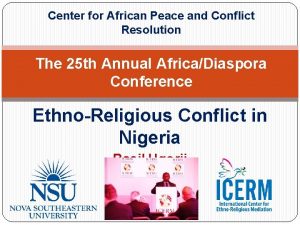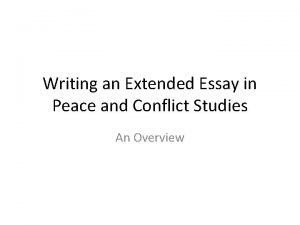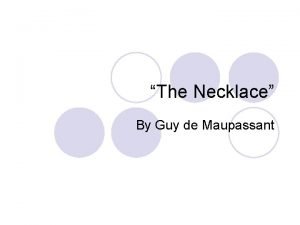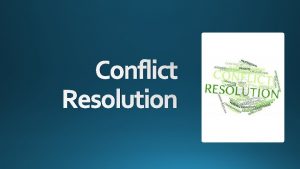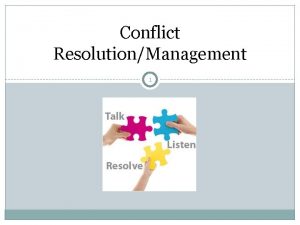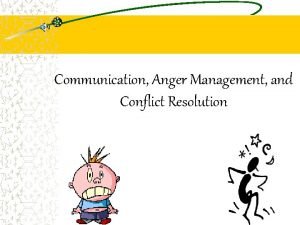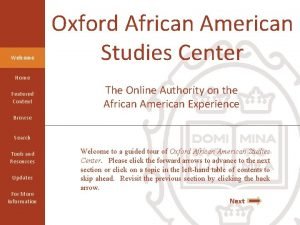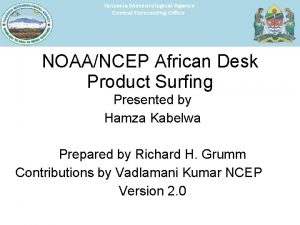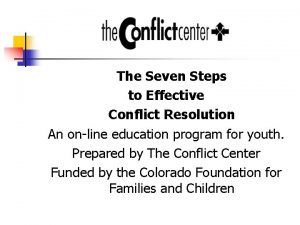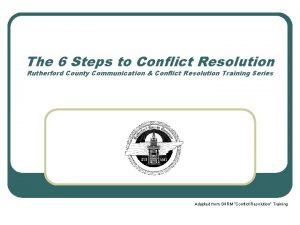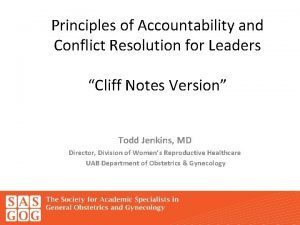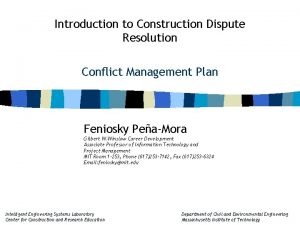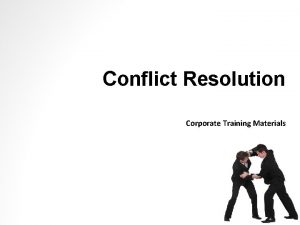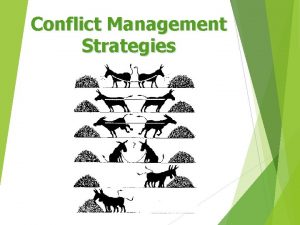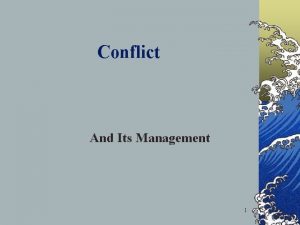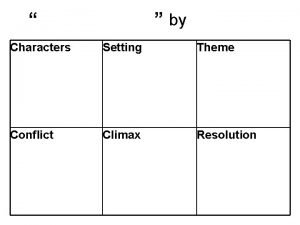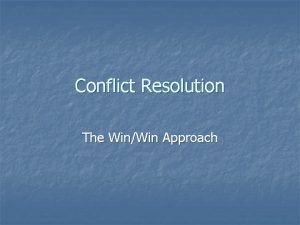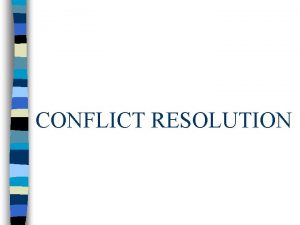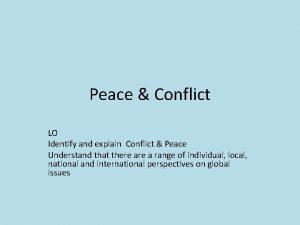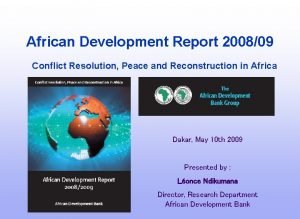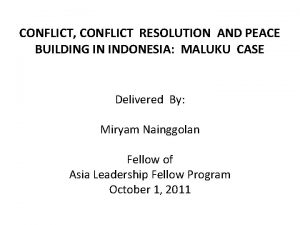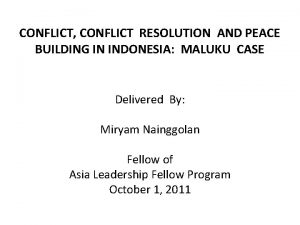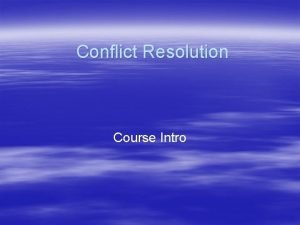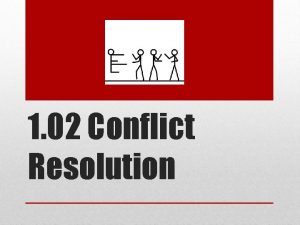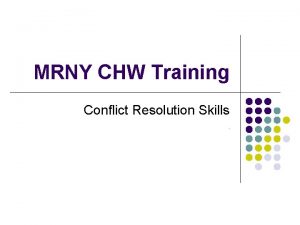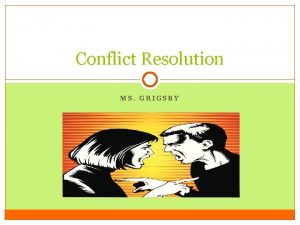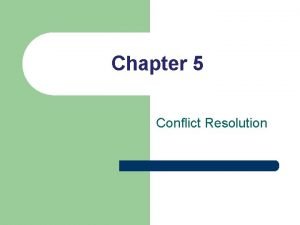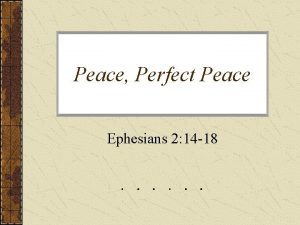Center for African Peace and Conflict Resolution The






























- Slides: 30

Center for African Peace and Conflict Resolution The 25 th Annual Africa/Diaspora Conference Ethno-Religious Conflict in Nigeria Basil Ugorji (April 21, 2016)

Learning Objectives �Discover ethno-religious conflict in Nigeria. �Understand the drivers, dynamics and sources of the conflict. �Review the pre-manifest conflict processes (pre. MCPS) during the formative years of Nigeria, between 1914 and 1945, a historic period commonly known as the amalgamation era. �Reflect on the manifest conflict processes (MCPS) in Nigeria during the struggle for decolonization and the early years of independence (1945 – 1966). �Contemplate on the aggressive manifest conflict processes (AMCPS) in Nigeria during the post-

Preliminary Considerations: Discover Ethno-Religious Conflict in Nigeria � Current debate on the peaceful coexistence of the various ethnic groups on the one hand, and between Christians and Muslims on the other. � A debate rooted in the 1914 amalgamation of the Northern and Southern Protectorates. � Living Together in Peace and Harmony emerged in the Nigerian national debate as a result of the numerous violent confrontations: Ø between and among ethnic groups in the north and south; and Ø between some Muslims and some Christians. � The recent surge of the Boko Haram terrorist attacks have continued to reignite the old debate on what it means for Muslims and Christians, Igbos, Hausa-Fulanis, Yorubas and the ethnic minorities in the different

Ethno-Religious Violence: A Threat to National Unity � Nigeria National Conference: On March 17, 2014, President Goodluck Jonathan convened and inaugurated the Nigeria National Conference, a National Dialogue, mandated to deliberate on all matters that militate against Nigeria’s national unity and progress. � Findings: The Conference acknowledged the incessant hostility and violent confrontations that currently exist between ethnic groups in Nigeria. � The delegates unanimously agreed that the new wave of religious violence and terrorism pose a serious threat to the “secular character of the state, and the idea of one nation v bound in freedom, peace and unity” (Final Draft of Nigeria Other issues raised by scholars and analysts include: Ø National Conference Report, 2014, p. 47). Religious freedom Ø A sense of collective identity (ethnic, religious, and national) Ø Need to prevent further violence; strengthen north-south and Muslim-Christian relationships; and construct a

�This presentation offers a different perspective to the existing body of literature. �The drivers, dynamics and sources of ethnoreligious conflict in Nigeria ought to be seriously studied analyzed before proposing solutions. �Drawing on selected social conflict and conflict resolution theories, I will outline the parties, issues and possible solutions to the conflict.

Analysis of the Drivers, Dynamics and Sources of Ethno. Religious Conflict in Nigeria � Method of Analysis Used: Ø The medico-diagnostic method of inquiry. ü Examine the symptoms. ü Identify the nature of the illness. ü Understand the patient’s medical condition and history. ü Find the particular area the illness is located in the body system. ü Discover the level of danger the illness poses to the life of the patient. � Application to ethno-religious conflict: Ø In a similar manner, “efforts to ameliorate” ethno-religious conflict in Nigeria “must be preceded by an understanding” of the drivers, dynamics and sources of that conflict. Ø “Altogether too many policy prescriptions for ethnic harmony have been dispensed without benefit of careful diagnosis” (Horowitz, 2000). Ø The analysis of ethno-religious conflict in Nigeria that this

Sandole’s Stages of Conflict Manifestation Conflict, according to Sandole, is “a process characterized by stages of initiation, escalation, controlled maintenance, de-escalation and some kind of termination (e. g. , settlement, resolution)” (as cited in Cheldelin, Druckman & Fast, 2008, p. 42– 43). Conflict Stages Initiation Escalation Controlled Maintenance Conflict Processes Latent conflicts or pre-manifest conflict processes (pre. MCPs) Manifest conflict processes (MCPs), Aggressive manifest conflict processes (AMCPs)

Progressive Manifestation of Ethno. Religious Conflicts in Nigeria Based on the historical and political perspectives, ethno-religious conflict in Nigeria could be analyzed and categorized into three phases; each phase corresponds to one of Sandole’s stages of conflict manifestation. Sandole’s Conflict Latent conflicts or Manifest conflict Processes pre-manifest processes (MCPs) conflict processes (pre-MCPs) Aggressive manifest conflict processes (AMCPs) Phases of Ethno. Religious Conflict Manifestation in Nigeria Phase 3: From “the collapse of the First Republic following a bloody military coup that ushered in the first military regime and sparked up a movement for democratization” and continues until the current Phase 1: The period of “amalgamation and the problem of nationhood” (See the Final Draft of Nigeria National Conference Report, 2014) Phase 2: A period marked by the struggle for “decolonization, the agitation for constitutional reform, and the early years of independence”

Caution & Note �By categorizing the manifestations of ethno-religious conflicts in Nigeria into three politico-historical phases, I do not claim that some forms of conflicts discussed in phase 1 did not occur in phase 2 and phase 3; or that phase 3 conflict types did not occur in phase 2 and 1, and so on. �The three categories are established to facilitate a conceptual analysis of the levels of intensity of ethnoreligious conflicts within a historical and political entity called Nigeria. �In each of the conflict phases, an attempt will be made to identify: Ø the elements, causes (sources or drivers) and conditions that encourage ethno-religious conflict in Nigeria,

Phase One: Pre-Manifest Conflict Processes (pre. MCPs) in Nigeria (The period of “amalgamation and the problem of nationhood” 1914 - 1945) �A call to return to the formative years of Nigeria, between 1914 and 1945, a historic period commonly known as the amalgamation period characterized by the “problem of nationhood” (Final Draft of Nigeria National Conference Report, 2014, p. 4). �Definition: Amalgamation could be understood as a uniting or combining action by somebody or an agency on two or more separate, dissimilar entities or groups. �In other words, it is the action, process, or result of merging, combining or uniting two or more separate, autonomous groups, entities, ethnicities, regions, or nations into one “Nation” (with the uppercase “N”).

Two Forms of Amalgamation Consented Amalgamation � Indigenous peoples and nations freely decided to merge in a united nation. � Based on the ethical principle of respect for persons or groups with certain inalienable rights. � Based on clarity and full understanding of the terms, expectations, implications, risks and opportunities that are associated with amalgamation. � The groups’ consent is based on a well-informed decision. � Presence of a condition or situation that encourages free “voluntariness” and Forced Amalgamation �Union by coercion and compulsion. �Lack of prior information, contact with each other; and �Against the will of the indigenous peoples.

Was the 1914 amalgamation of the Northern and Southern Protectorates that created the Nigerian nation a consented amalgamation or a forced amalgamation? v Historical narratives of the 1914 amalgamation in Nigeria and the agitation that followed it as well as available literature confirm that the amalgamation of the north and south was not by choice but by force. v So, should the British be blamed for the manifestations of ethno-religious conflicts in Nigeria, especially those that occurred between some ethnic groups from the north and some from the south, and between Muslims and Christians? v No need for a litany of blame against colonialism and the colonialists. v Instead it is important to learn from it by understanding how and why latent hostility and conflict developed during the time of amalgamation between the north and south of

What are latent conflicts? “Conflicts that are developing, but have not yet expressed themselves in an observable manner, even for the parties themselves” (Sandole, as cited in Cheldelin et al. , 2008, p. 43) What causes and drives these dormant conflicts? What are their sources? From a general perspective From a theoretical perspective Territories were administered separately (divide and rule). correlation between in-group selfconsciousness and bonding, and outgroup hostility and competition could be explained through the “Robbers Cave Experiment” (Pruitt & Kim, 2004, p. 27– 28). Educated elites were excluded from colonial administration. This is an experiment conducted by Muzafer Sherif and his colleagues in the summer of 1954 at the state park in the Sans Bois mountains of Oklahoma on intergroup conflict. Consequence: the awakening and reinforcement of: in-group selfconsciousness (or self-awareness) and bonding; and out-group hostility and A group “can be defined as two or more people who have a common identity and a capacity for coordinated action” (p. 27).

Robbers Cave Experiment” (Pruitt & Kim, 2004): � Muzafer Sherif and the other researchers of the “Robbers Cave Experiment” : � carefully selected twelve-year-old boys who were similar in virtually all ways. � They were divided into two groups of twelve each and brought separately to the campsite, so that for several days they were unaware of the presence of another group. � The boys did typical summer camp activities – canoeing, swimming, making meals, setting up tents, playing baseball at a nearby baseball field, and the like. � As expected, group bonding – “we” feelings – emerged quickly. Both groups adopted a group name: the “Rattlers” and the “Eagles. ” � After several days, the groups discovered one another’s presence and were eager to compete with each other in team sports. � Even before actual contact took place, competitive, often

Relevance of the early stage of “Robbers Cave Experiment” to the understanding of the latent conflicts that occurred in the early years of Nigeria – the amalgamation period characterized by the “problem of nationhood” - between 1914 and 1945 �Like in the “Robbers Cave Experiment, ” the latent conflict perceived in the early years of the Nigerian experiment has many elements. �What are conflict elements? �They are the “distinguishing characteristics” of any particular conflict. �This means that to have a deeper understanding of a conflict, one has to decipher what its elements are. �To this end, Sandole’s six elements of conflict are pedagogically illustrative (as cited in Cheldelin, et al. , 2008).

Six Elements of Conflict �Parties: the very actors or agents in conflict. �Issues: the reasons parties claim they are waging conflict with each other. �Objectives: the status-quo-changing and status-quomaintaining options. �Means: the method used by parties to achieve their objectives, including violent and non-violent forms of conflict. �Conflict-handling orientations: different approaches used by parties to a conflict. �Conflict environments within which conflicts occur: the conflict setting which includes, endogenous and exogenous environments (To learn more, see Sandole,

For a deeper understanding of the latent conflicts that occurred during the amalgamation period, it is instructive to quickly identify the parties involved and the issues in conflict while making reference to the other elements of conflict as discussed above. Parties Involved Issues in Conflict � The British colonial government. � Exclusion from the decision making processes. � The northern region including its dominant ethnic group – the � Autonomy of the various Hausa-Fulani who are mainly ethnic nationalities within Muslims – and its minority the two regions as well as ethnic groups as well as the old autonomy of the regions. Middle Belt populations. � Self-determination. � The southern region which was � Territorial integrity. later divided into two: the southwest where the Yoruba � The British colonial tactic of ethnic group is located with a divide and rule. high Christian population and a � Economic opportunities. small Muslim population, and the southeast occupied by the � Political representation. Igbo ethnic group and other minority ethnic and tribal groups

Issues in Conflict �These seven concealed, hidden, underlying or pre-manifest conflict issues during the period of amalgamation are carefully selected and should therefore be examined individually.

Issue 1: Exclusion from the decision making processes �The 1914 amalgamation of the Northern and Southern Protectorates that created the Nigerian nation was a British colonial initiative. �This provoked bitter controversy at the time, arousing the resentment of educated elites. �Educated elites were excluded from colonial administration […] they advocated for an appointment and deposition of chiefs by their own people and greater participation in government (See Final Draft of Nigeria National Conference Report, 2014, p. 4).

Issue 2: Autonomy of the various ethnic nationalities within the two regions as well as autonomy of the regions �Remember the distinction between consented amalgamation and forced amalgamation �From this distinction, think of how forced amalgamation can serve as a catalyst for an autonomy -based conflict. �The fact that the various ethnic groups within each region were coerced to unite - first within one broader region, and second to form a united, one nation - against their will and without informed consent is by itself a violation of the autonomy of the indigenous peoples of Nigeria, and by implication a violation of their basic human rights.

Issue 3: Self-determination �Self-determination here means a process by which a group or an ethnic nationality freely controls or determines to the full extent possible its own affairs and future without any external influences. �With the sudden advent of the British initiated and engineered amalgamation, however, the pre-1914 ethnic nationalities in Nigeria lost their right to self-determination. �In order to regain this right, “early Nigerian nationalists began to advocate for a national dialogue to discuss the future political development of the amalgamated territories as a single and unified Nigerian nation. They also demanded for participation in the management of their own affairs” (See Final Draft of Nigeria National Conference Report, 2014, p. 5).

Issue 4: Territorial integrity �Integrity in this context does not mean an action of being honest or upholding everyday moral principles. �By territorial integrity, it means wholeness and undivided. �Each of the pre-amalgamation ethnic groups was whole and undivided, and to some extent, enjoyed territorial autonomy with limited contact with other ethnic nationalities in the other regions. �However, colonization in West Africa - and its premier outcome, amalgamation - devirginized the purity, integrity and sovereignty of the ethno-national territories.

Issue 4: Territorial integrity continues �Aime Cesaire (as cited in Lemert, 2013) clearly describes this situation by saying that: �Every day that passes, every denial of justice, every beating by the police, every demand of the workers that is drowned in blood, every scandal that is hushed up, every punitive expedition, every police van, every gendarme and every militiamen, brings home to us the value of our old societies. They were communal societies, never societies of the many for the few. They were societies that were not only antecapitalist, as has been said, but also anti-capitalist. They were democratic societies, always. They were cooperative societies, fraternal societies. I make a systematic defense of the societies destroyed by

� These changes divided a people who were initially bound together by tradition, culture, language, religious liturgy and practices, and so on, into two or more territories where they joined outsiders to form what is considered today as a nation-state. � Two examples will suffice. � The Yoruba people are divided across different countries in West Africa: Nigeria, Republic of Benin, Togo and even Ghana. � The ancient kingdom of Biafra included some parts of the present day Equatorial Guinea, Cameroon, and Gabon (Government of IPOB, 2014). � The two questions that need to be answered are: � Is the “imposition by force of a border change” considered in international law as “an act of aggression” (El Ouali, 2012)? � If yes, will the colonialists, like the British government, who forcibly modified the borders of the indigenous peoples and violated their right to territorial integrity be held accountable for their crime and the resultant conflicts? � The scope of this presentation will not allow a probe into the various international laws about this subject. � These questions will be left for future research by experts or students of international law on territorial integrity and sovereignty. � Our goal here is to highlight territorial integrity as a latent conflict

Issue 5: The British colonial tactic of divide & rule � As the term “divide and rule” suggests, the British colonial masters used a cunning tactic called indirect rule to govern the peoples of Nigeria to their own detriment and to the advantage of the British power. � By indirect rule, the British further deepened the existing division in the country and ruled through the existing traditional and customary structures in order to maintain their hegemony and power influence on the people. � What this means is that the traditional and customary leaders through whom the British governed the ethnic groups and peoples, and the regions, were working for the colonial government. � They were merely instruments - a means to an end and were never an end in themselves. � Simply put it, they were exploited and used to suppress, oppress and subdue their own people, especially those within and outside, who were against the colonial throne. � As the human factor issues could come to play, especially within the northern region, the minority ethnic groups, and most visibly the

Issue 6: Economic opportunities �The mélange of the peoples of Nigeria provoked some forms of hostile behaviors and competition between in-group and out-group members, as well as between the indigenous peoples and the foreign expatriates. �Within the northern region that was administered through the indirect rule system, the minorities were greatly discriminated against in the civil service, and the same occurred in the other regions. �The British administrators also discriminated against the indigenous peoples in high paying jobs as the latter were reserved for the white expatriate masters. �This is the reason why the pro-nationalist movement in Nigeria at this time advocated for the “abolition of racial discrimination in the civil service” (Final Draft of Nigeria National Conference Report, 2014, p. 5).

Issue 7: Political representation � The British colonial administrators were reluctant to form a representative government during this period. � Rather they were more interested in an exploitative indirect rule tactic. � The bubbles of this latent conflict were first released in a demand made by the pro-nationalist movement advocates. � They demanded that a “Legislative Council” be established, “half of whose members should be elected Africans » (Final Draft of Nigeria National Conference Report, 2014, p. 5). � But the colonial authority did not listen to the demands of the indigenous peoples because of an inherent fear “that their aspiration to greater participation in government had the ultimate aim of displacing the British administration” (Final Draft of Nigeria National Conference Report, 2014, p. 5). � Unfortunately, the bubbles of this latent conflict exploded during the struggle for decolonization and early years of independence between 1945 and 1966, a period I call the era of Manifest Conflict Processes (MCPs) in Nigeria (1945 – 1966), which in-turn

Conclusion � Because of time constraint, my analysis focused on the pre- manifest conflict processes during the amalgamation period (from 1914 to 1945). � I identified seven concealed, hidden, underlying or pre-manifest conflict issues that characterize this era, including: exclusion from the decision making processes; autonomy of the various ethnic nationalities within the two regions as well as autonomy of the regions; self-determination; territorial integrity; the British colonial tactic of divide and rule; economic opportunities; and lastly, political representation. � The paper that addresses the second and third stages of conflict manifestation - the manifest and aggressive manifest conflict processes – as well as a proposed paradigm shift for their resolution are available for those who are interested. � Since the amalgamation of the north and south of Nigeria was based on a fragile foundation, the bubbles of the latent conflicts of the amalgamation era exploded during the struggle for

References � Adamolekun, T. (2013). A historical perspective in the Christian-Muslim relations in Nigeria since 1914. Journal of Arts and Humanities (JAH), 2(5), 59 -66. Retrieved from http: //www. theartsjournal. org/ � Adesoji, A. (2010). The boko haram uprising and Islamic revivalism in Nigeria. Africa Spectrum, 45 (2), 95 -108. Retrieved from http: //www. jstor. org/stable/25798918 � Agbiboa, D. E. (2013). Why boko haram exists: The relative deprivation perspective. African Conflict and Peacebuilding Review, 3 (1), 144 -157. doi: 10. 2979/africonfpeacrevi. 3. 1. 144 � Bolaji, M. H. (2013). Between democracy and federalism: Shari'ah in northern Nigeria and the paradox of institutional impetuses. Africa Today, 59 (4), 93 -117. doi: 10. 2979/africatoday. 59. 4. 93 � Casey, C. (2008). Marginal Muslims: Politics and the perceptual bounds of Islamic authenticity in northern Nigeria. Africa Today. 54 (3), 67 -92. Retrieved from http: //www. jstor. org/stable/27666908 � Cheldelin, S. , Druckman, D. , & Fast, L. (2008). Conflict, 2 nd ed. London: Continuum Press. � Crowther, M. (1968). West Africa under colonial rule. London: Hutchinson & Co. � Coser, L. (1956). The functions of social conflict. An examination of the concept of social

� Horowitz, D. L. (2000). Ethnic groups in conflict. Los Angeles: University of California Press. � Kenny, J. (1996). Sharia and Christianity in Nigeria: Islam and a 'secular' state. Journal of Religion in Africa, 26 (4), 338 -364. doi: 10. 2307/1581837 � Kymlicka, W. (1995). Multicultural citizenship: A liberal theory of minority rights. New York: Oxford University Press. � Lemert, C. (Ed. ) (2013). Social theory: The multicultural, global, and classic readings. Boulder, CO: Westview Press. � National Commission for the Protection of Human Subjects in Biomedical and Behavioral Research. (1979). The Belmont Report. Retrieved from http: //www. hhs. gov/ohrp/humansubjects/ � Nigeria National Conference. (2014). Final draft of conference report. Retrieved from https: //www. premiumtimesng. com/ � Pruitt, D. , & Kim, S. H. (2004). Social conflict: Escalation, stalemate and settlement (3 rd ed. ). New York, NY: Mc. Graw Hill. � Salawu, B. (2010). Ethno-religious conflicts in Nigeria: Causal analysis and proposals for new management strategies. European Journal of Social Sciences, 13 (3), 345353. Retrieved from https: //www. eisf. eu/ � Sampson, I. (2014). Religion and the Nigerian state: Situating the de facto and de jure frontiers of state–religion relations and its implications for national
 Center for african peace and conflict resolution
Center for african peace and conflict resolution What is conflict and conflict resolution?
What is conflict and conflict resolution? Center for conflict resolution kansas city
Center for conflict resolution kansas city Peace topic
Peace topic What is the difference between christian and catholic
What is the difference between christian and catholic High resolution low resolution
High resolution low resolution Settings in the necklace
Settings in the necklace Watch mastering conflict management and resolution at work
Watch mastering conflict management and resolution at work Foreshadowing in the alchemist
Foreshadowing in the alchemist Watch mastering conflict management and resolution at work
Watch mastering conflict management and resolution at work Conflict in the treasure of lemon brown
Conflict in the treasure of lemon brown Mastering conflict management and resolution at work
Mastering conflict management and resolution at work Anger management and conflict resolution
Anger management and conflict resolution Anger management and conflict resolution
Anger management and conflict resolution Oxford african american studies center
Oxford african american studies center Cpc africa desk
Cpc africa desk Cudsa stands for
Cudsa stands for Resume format sample for work immersion
Resume format sample for work immersion What are the 7 steps in conflict resolution?
What are the 7 steps in conflict resolution? 6 steps conflict resolution
6 steps conflict resolution Customer service conflict resolution
Customer service conflict resolution Accountability in conflict resolution
Accountability in conflict resolution Conflict resolution outline
Conflict resolution outline Conflict resolution skills
Conflict resolution skills Conflict resolution training materials
Conflict resolution training materials Conflict resolution exercise
Conflict resolution exercise Scope of conflict resolution
Scope of conflict resolution Steps in the mediation process
Steps in the mediation process Theme of zoo by edward hoch
Theme of zoo by edward hoch Staben conflict resolution
Staben conflict resolution Conflict resolution win win
Conflict resolution win win
